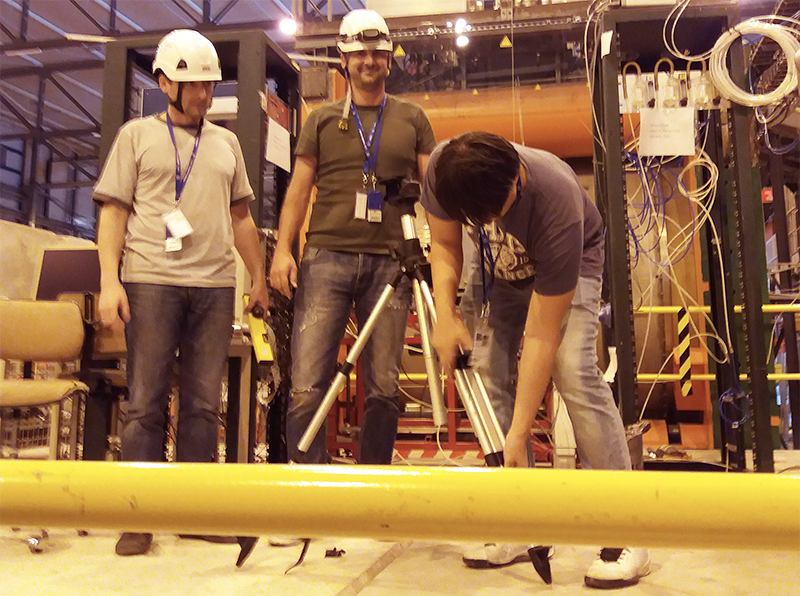
Testing materials for RPCs at CERN
Paulo Fonte (LIP Coimbra) & Imad Laktineh (IN2P3), 12/12/2017

Researchers at CERN aligning the small setup with the beam (Image: Imad Laktineh)
In September 2017, researchers involved in the AIDA-2020 project’s Work Package 13 (WP13) addressing innovative gas detectors performed a test at the Super Proton Synchrotron (SPS) beam area at CERN, using both muon and hadron beams.
Tasks of WP13 aim at investigating new resistive materials for high-rate Resistive Plate Chambers (RPC) and at developing fast-timing large RPCs. The development of RPCs able to perform at higher count rates per unit area is very important for detection technology, as these are one of the leading large-area detectors, particularly for timing. This can be achieved by the incorporation of plates made of lower resistivity materials. Unfortunately, there are few convenient technical choices which offer the resistivity range required.
A set of eight RPCs, containing four different electrode materials with varying levels of resistivity, were jointly tested in the North Area beamline. The researchers aimed to evaluate their adequacy for the construction of RPCs with extended rate capability by analysing their behaviour as either anodes or cathodes.
The four materials under consideration were: 1) carbon nanofilament loaded polyvinylidene fluoride (PVDF) plastic; 2) KREFINE® carbon-loaded polyether ether ketone (PEEK) plastic; 3) phosphate glass provided by Thsingua University, Beijing, PRC; and 4) thin ordinary soda-lime glass. The results of the testing showed the DC resistivities of the materials were, respectively: 2.6×1010 W×cm (two bonded layers), 1.5×1010 W×cm, 3×1010W×cm and 1013 W×cm.
The chambers, including the four materials under test, were single-gap RPCs, each constituted by one stainless steel electrode and one resistive electrode in a spacer-free construction, forming a gas gap of 1 mm. The chambers were housed in a common gas-tight enclosure flushed with a gas mixture of 95% tetrafluorethane and 5% of sulphur hexafluoride.
During the seven-day test, the chambers were illuminated by defocussed beams of pions or muons, tagged by auxiliary scintillators, up to the highest intensities available at the beamline. The currents, charge spectra and counting rates were continuously recorded for later analysis.
Simultaneously, the Semi-Digital Hadronic CALorimeter (SDHCAL) with its 48 large glass RPC equipped with their embedded electronics (420,000 channels in total) was also exposed to muon and hadron beams. The aim of this test was to study the difference of the hadronic showers produced by pions from those produced by protons. To achieve this study two Cerenkov counters were used. The first one was used to reject the electron contamination while the second one to tag the pions providing thus a way to discriminate the latter from protons and kaons present in the beam.
In addition, different calibration schemes were tested in order to reach the most uniform response to hadrons in this technological prototype. As for the previous tests the triggerless mode and a power-pulsing scheme using the SPS duty cycle were applied. The preliminary results are very encouraging and confirm the high capability of gaseous detectors to be used as active layer in high-granularity calorimeters.
